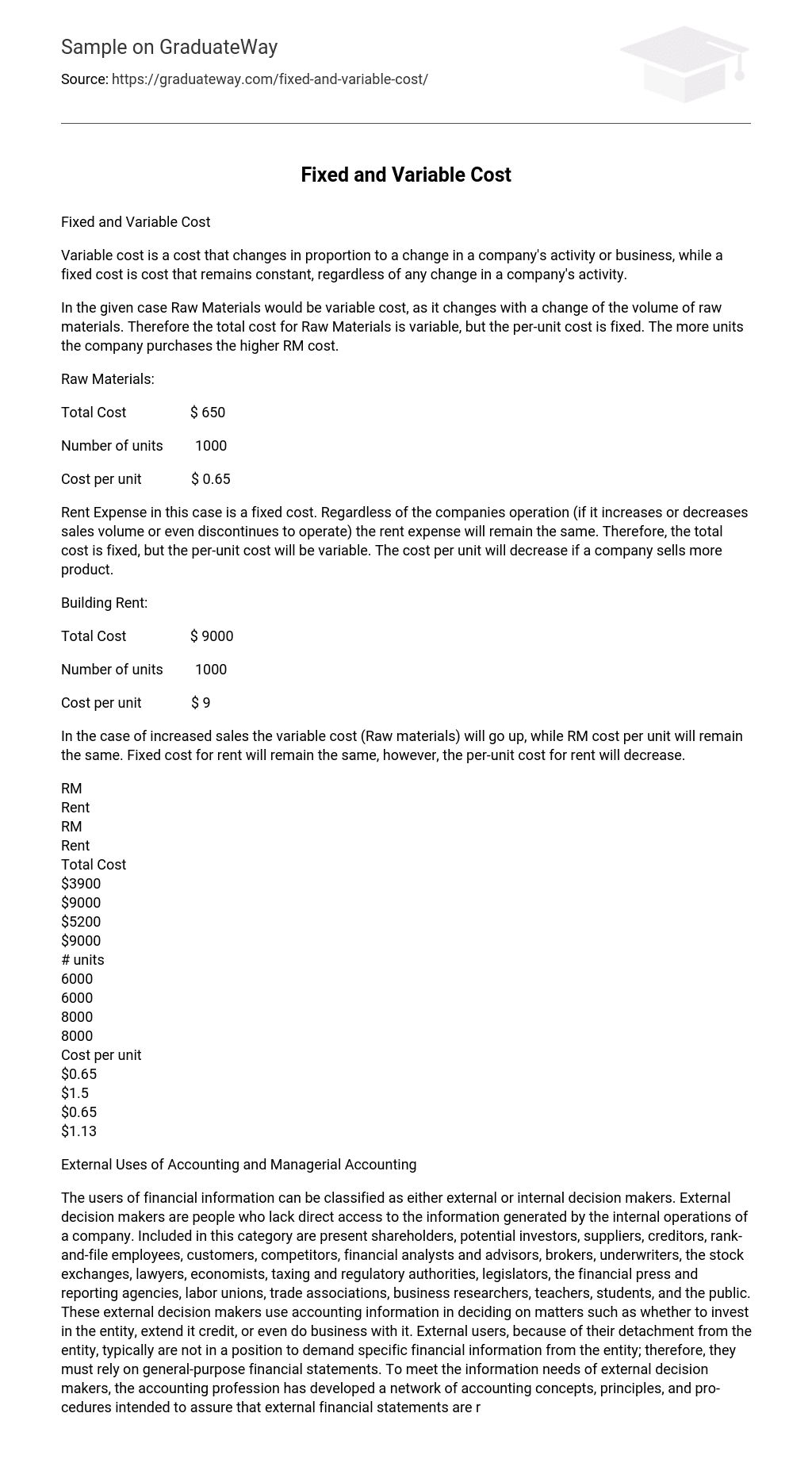Variable cost is a cost that changes in proportion to a change in a company’s activity or business, while a fixed cost is cost that remains constant, regardless of any change in a company’s activity.
In the given case Raw Materials would be variable cost, as it changes with a change of the volume of raw materials. Therefore the total cost for Raw Materials is variable, but the per-unit cost is fixed. The more units the company purchases the higher RM cost.
Raw Materials:
Total Cost $ 650
Number of units 1000
Cost per unit $ 0.65
Rent Expense in this case is a fixed cost. Regardless of the companies operation (if it increases or decreases sales volume or even discontinues to operate) the rent expense will remain the same. Therefore, the total cost is fixed, but the per-unit cost will be variable. The cost per unit will decrease if a company sells more product.
Building Rent:
Total Cost $ 9000
Number of units 1000
Cost per unit $ 9
In the case of increased sales the variable cost (Raw materials) will go up, while RM cost per unit will remain the same. Fixed cost for rent will remain the same, however, the per-unit cost for rent will decrease.
RM
Rent
RM
Rent
Total Cost
$3900
$9000
$5200
$9000
# units
6000
6000
8000
8000
Cost per unit
$0.65
$1.5
$0.65
$1.13
External Uses of Accounting and Managerial Accounting
The users of financial information can be classified as either external or internal decision makers. External decision makers are people who lack direct access to the information generated by the internal operations of a company. Included in this category are present shareholders, potential investors, suppliers, creditors, rank-and-file employees, customers, competitors, financial analysts and advisors, brokers, underwriters, the stock exchanges, lawyers, economists, taxing and regulatory authorities, legislators, the financial press and reporting agencies, labor unions, trade associations, business researchers, teachers, students, and the public. These external decision makers use accounting information in deciding on matters such as whether to invest in the entity, extend it credit, or even do business with it. External users, because of their detachment from the entity, typically are not in a position to demand specific financial information from the entity; therefore, they must rely on general-purpose financial statements. To meet the information needs of external decision makers, the accounting profession has developed a network of accounting concepts, principles, and procedures intended to assure that external financial statements are relevant and reliable (GAAP).
Internal decision makers are the managers of an entity. They are responsible for planning the future of the business, implementing those plans, controlling daily operations, and reporting information to other operating officers. Because of their close and direct relationship with the business, internal decision makers usually can obtain whatever financial data they need at dates of their choice. Much of this information is not intended to be relayed to outsiders. The process of developing and reporting financial information for internal users is called management accounting, and the related information reports being generated are called internal management reports. Because of the confidential nature of these reports and their primary focus on internal decision-making needs, there is no requirement (other than those specified by the management) that these reports conform to GAAP.
The objective of external financial statements and their accompanying disclosure notes is to communicate information concerning the economic effects on the reporting entity of completed business transactions and other events. Although there are other ways to communicate external financial information—such as prospectuses (for security offerings), news releases, and management “letters”—the primary means of communication are a company’s periodic financial statements. General-purpose financial statements report financial information of relevance to investment, credit, and public-policy decision makers.
The overall purpose of financial reporting as stated in SFAC No. 2 is to provide information that will be useful in making decisions. This objective influences the measurement rules and processes selected in preparing accounting information for financial-reporting purposes. If an alternative, less decision-oriented objective were to be adopted, the way accounting information is measured and reported would change dramatically.
;





